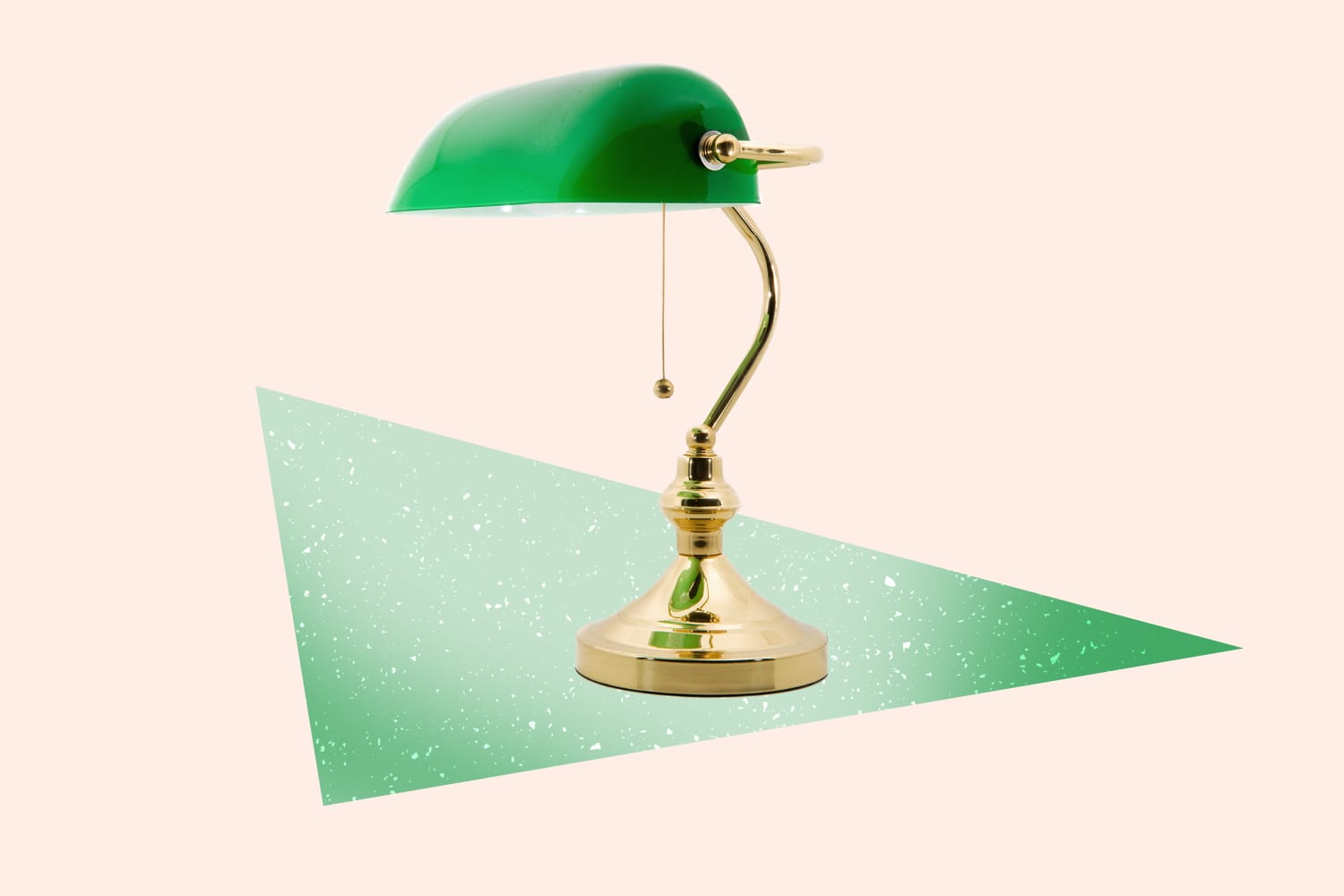[ad_1]
Picture yourself in an oak-paneled study: the kind where there are leather club chairs, shelves lined with books, and a roaring fire in the fireplace. Naturally, there’s a desk in this office, and on top of it, a lamp. Maybe your mind has already filled in the blank. The lamp, in this case, is a banker’s lamp, with a brass base and kelly-green shade.
Banker’s lamps seem to be most at home in these sort of scholarly environments, surrounded by writing instruments and antique furniture. I first took notice of them as a kid, watching the opening credits of “Murder, She Wrote” on a sick day. During the sequence, Angela Lansbury clacks away on her typewriter beside that iconic green lamp. I’ve grown to love both Murder She Wrote and banker’s lamps since then, and am typing these very words beside the soft glow of a green lampshade.
Banker’s lamps, or accountant’s lamps, aren’t just part of the aesthetic of fictional amateur sleuth Jessica Fletcher. They appear in libraries, actual banks, lawyer’s offices, and plenty of academic environments; they’re practically everywhere if you think to look for them.
A brief history of the banker’s lamp
The first banker’s lamp was switched on in 1909, thanks to a New York City engineer named Harrison D. McFaddin. His patent application stated he sought to create “a new, original and ornamental design for lamp shades.” He dubbed his design Emeralite, and through his father’s housewares company, H.G. McFaddin & Co., McFaddin began to manufacture the lamps, though the now-famous green glass shades were produced in a factory in Moravia, or the present-day Czech Republic.
The appeal, it seemed, was undeniable, and other companies followed suit. “Greenalite,” “Verdelite,” and “Amronlite,” lamps hit the market in the years after, but the Emeralite brand is the “by far considered the premier banker’s lamp,” according to Bruce Bleier, a banker’s lamp expert, collector, and creator of emeralite.com. He has hundreds of antique lamps — about a dozen of them are authentic Emeralite banker’s lamps — displayed on custom-built shelves in his home.
“A good Emeralite lamp is timeless,” Bleier tells me. “I mean, decade after decade, it’s appealing and it stands the test of time.”
Bleier practically scoffed at the cheap imitation that sits on my desk. He is a banker’s lamp purist and I am merely a fool who thinks it’s fine to buy banker’s lamps at Staples. True Emeralite lamps are no longer in production, but he understands why big-box stores would sell reproductions, of course. They’ve become a natural addition to offices.
“It’s hard to find someone who doesn’t find a banker’s lamp appealing,” Bleier says. “It’s like comfort food for your desk.”
Why banker’s lamps are green
Banker’s lamps were supposedly designed with comfort in mind: their rounded green shades are meant to be easy on the eyes. That’s how they were advertised in the 1930s anyway, when they garnered a wider appeal.
“A lighting system (using standard Mazda bulbs) designed to protect eyes by eliminating glare and improving quality of light,” reads an Emeralite ad. “Comprised of lamps for every reading, writing, and working need in home, office, and industry.”
The green-tinted light was supposed to make reading and writing easier for people who spent long hours doing those things. Some sources point to the green visors, or eyeshades, that accountants once wore as proof of this.
In terms of actually reducing eye strain, “It’s nonsense,” according to Dr. Matthew Gardiner, an ophthalmologist at Massachusetts Eye and Ear. “If you like green light, I suppose it’s fine. But there’s no evidence that it’s any better for you than any other light, or that it’s any less harmful, because light is light.”
Banker’s lamps were the blue-light blocking glasses of their day, marketed for their (supposed) health/lifestyle benefits. People have always been concerned about lights and eye strain, Gardiner explains, from the advent of electricity, and later, television, to computer and phone screen concerns today.
“When you’re looking at a screen or concentrating on anything, even if you’re reading on paper, you will blink less and you get more evaporative loss and you get more dryness,” Gardiner says. “That is causing eye strain, but it has nothing to do with the light color.”
Still, the lamp’s sales pitch worked, and banks, libraries, and other institutions bought into the green-light-is-calming claim. Another Emeralite ad lists some of the company’s notable clients, such as Bell Telephone Co., General Motors, Harvard University, F. W. Woolworth & Co., and others.
“When I was in medical school, there was a library that had a whole row of tables with beautiful green lamps. And I used to love to go there because it looked so, you know, sort of old and stylish,” Gardiner adds. “But I can’t say it really helped me.”
The timeless ubiquity of banker’s lamps
Over the years, libraries in particular have been a popular setting for banker’s lamps, and there’s one that’s loaded with green shades: The Boston Public Library. Bates Hall, a stately reading room in the library’s circa 1895 McKim Building, is likely one of the most Instagrammed spots in all of Boston. Perhaps you’ve guessed why.
These lamps, while not the standard banker’s design, have carved out a soft spot in the hearts of Bostonians and visitors alike. According to Meg Weeks, the library’s curator of interpretation in the exhibitions department, they were installed in the room in the 1990s during a renovation that sought to honor the library’s original design intent. Preservation architects deduced from old photographs and documentation that early lamps in the room had dark green shades.
Weeks, who works on the library’s art and architecture tours, explains the building’s architect, Charles Follen McKim, specifically looked to the Bibliothèque Sainte-Geneviève in Paris for design cues, where seemingly endless rows of green lamps can be found on tables there. The ones in Bates Hall have made the room a destination in its own right.
“They’re beloved,” Weeks says. “And I think it speaks to the quality of the original architectural intent. Through the years, there were plenty of lighting adjustments made, but that was something very important to bring back and to honor, because they’re iconic.”
Banker’s lamps are ubiquitous, too, in television and movies through the decades. Sean Williamson, creator of thebankerslamp.com, has started cataloging their appearances in film. With the help of fellow lamp enthusiasts, he’s created a list that includes “Seinfeld,” “Frasier,” “Legally Blonde,” “Gilmore Girls,” “Goodfellas,” “Dick Tracy,” several James Bond movies, and more.
“Although the original company is long gone, the lamp design and its legacy still live on,” writes Williamson. “For me, the lamp is arguably one of the most recognizable desk lamps in the world, largely due to its frequent appearance in movies and TV-shows.”
As for the knockoff Emeralite lamp on my desk, I’ve spotted lookalikes in some of my other favorite shows: “Columbo,” “The Twilight Zone,” and a few Agatha Christie adaptations. But much like “Murder, She Wrote” will always be my comfort watch, my banker’s lamp will continue to be my comfort lamp.
[ad_2]
Source link











